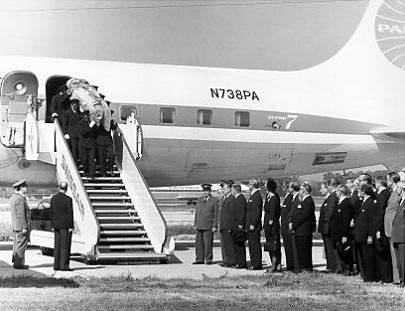Who Killed Hammarskjöld?
A new book reopens the 50-year-old mystery of how U.N. Secretary General Dag Hammarskjöld and 15 others died in a plane crash on September 18, 1961
/https://tf-cmsv2-smithsonianmag-media.s3.amazonaws.com/filer/56/0c/560c98e4-675d-4608-a0a2-6ab86a1aef1a/dag_hammarskjold.jpg)
That’s the title of a new book that reopens (for the umpteenth time) the 50-year-old mystery of how, or rather why, U.N. Secretary General Dag Hammarskjöld and 15 others died in a plane crash on September 18, 1961, during a peacekeeping mission to Congo. Was it really just an accident, as official investigations concluded at the time? Or was the Swedish diplomat murdered by European or American interests scheming to keep control of Congo’s mineral resources or advance some Cold War strategy?
Author Susan Williams goes over all the rumors and inconsistencies that have fueled conspiracy theories for half a century: bullets found in the bodies of two of the Swedish soldiers onboard the crashed Douglas DC-6B; the fact that Hammarskjöld’s body was found at a distance from the charred wreckage, and was the only one of the 16 that wasn’t burned; the mysterious “playing card” reportedly sticking out from his collar in photographs taken on the scene—was it the ace of spades, the “death card?” After weighing the evidence, digging through previously secret files, and interviewing the obligatory Eyewitnesses Only Now Breaking Their Silence, Williams comes to the conclusion, as quoted in The Guardian, that “We don’t have any smoking gun or killer evidence but on the balance of probability on the basis of the evidence I collected, my view would be that the Hammarskjöld plane was attacked in the sky by a second plane.” The Secretary General’s nephew has called for a new inquiry into the accident.
But if others are to be believed, the answer is far more mundane, and there’s no villain in this story. It was The Big Sleep that did it: The DC-6 pilots were simply so tired at the end of their six-and-a-half-hour night flight that they lost their bearings, came in too low, and crashed into the trees. “By using modern fatigue models, we can show that the schedule that this crew flew on the day of the accident would have made them tired to a point of impairment when the accident occurred,” Flight Safety Foundation president William Voss told the Associated Press.
Rather than try to settle the matter definitively, which may be impossible after all these years, maybe it’s best to fall back on the extremely thorough April 1962 U.N. report on the crash. Was it sabotage? “There is no convincing evidence that any witness heard or saw an explosion before the crash,” concluded the investigators. Although one of the victims, who lived for a few days after the accident, spoke of an explosion, the investigators thought it likely he had heard the sound of the left wing being torn off as it struck the trees, or the fuel tanks exploding on impact.
Was the DC-6 shot down? Except for its too-low altitude, the aircraft was in a normal, level approach at the time it hit the trees, flying at a normal speed. So it wasn’t plummeting. Some technical malfunction, maybe? Again, the approach was perfectly normal except for being too low, and the recovered altimeters showed no obvious defects.
Human error? People have theorized that the pilots were using a chart for the wrong airport, or that they misread 4,600 feet on the altimeter for 6,400 feet, or, yes, that they were fatigued. But the DC-6 had three pilots onboard, and sleeping accommodations. Maybe the entire crew was momentarily distracted. Unfortunately, we’ll never know. And that’s about where the 1962 commission left it.
One matter they did settle, though, at least to their own satisfaction: Those bullets in the soldier’s bodies? They only barely penetrated the skin. When the airplane exploded, so had a cache of ammunition that was onboard. No mysterious gunman required.
